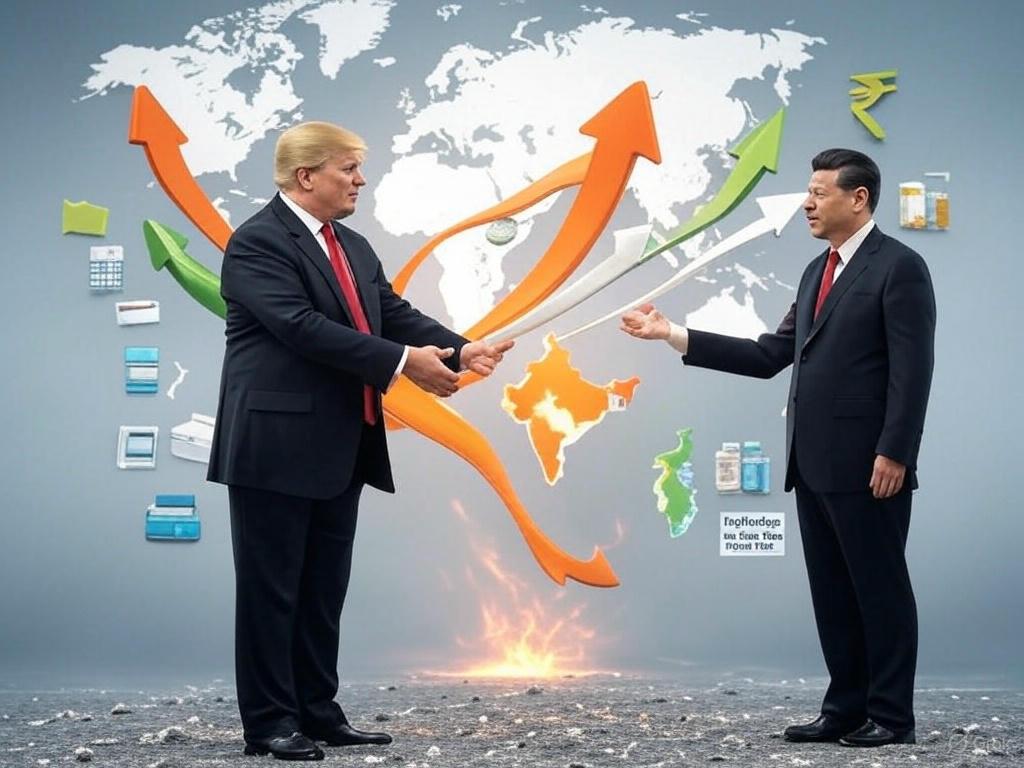
The Evolving Landscape of Global Trade and the US-China Trade War
The past few years have witnessed a significant surge in global trade tensions, with the trade war between the United States and China standing out as a particularly impactful development. Initiated by the US, this conflict stemmed from accusations of unfair trade practices and the alleged theft of intellectual property by China. In a bid to address a substantial trade deficit and protect domestic industries, the US administration began imposing tariffs on a wide range of Chinese goods. This action triggered a series of retaliatory measures from China, which responded with its own tariffs on US exports, leading to a continuous escalation of trade barriers between the two economic giants.
The imposition of these tariffs and the ensuing uncertainty have had a profound impact on global trade dynamics. Businesses heavily reliant on the US-China trade axis have been compelled to reassess their strategies, actively seeking alternative markets and suppliers to mitigate the risks associated with higher costs and unpredictable trade policies.5 This disruption to established global trade patterns has created a unique environment, presenting both considerable risks and significant opportunities for third-party nations like India. The imposition of tariffs by the world's two largest economies has inevitably led to increased costs for businesses involved in their trade. This situation has prompted a widespread re-evaluation of sourcing and market strategies, driving companies to explore diversification and alternative suppliers as a means to mitigate these emerging risks. This disruption extends beyond the bilateral relationship between the US and China, generating cascading effects throughout the entire global economy.
The sustained nature and increasing intensity of the trade war have fostered a prolonged period of opportunity for India. This extends beyond mere short-term gains in specific sectors to encompass the potential for significant long-term strategic advantages. While initial trade disputes might only induce temporary shifts in trade flows, a trade war that continues to escalate forces companies to undertake more fundamental and potentially permanent adjustments to their supply chains, manufacturing locations, and overall market approaches. This extended period of global economic realignment offers India a substantial and enduring window to strategically position itself and effectively capitalize on these transformative changes.
Surge in Indian Exports: Identifying Key Beneficiary Sectors
The imposition of tariffs by the United States on Chinese goods has led to a phenomenon known as trade diversion, where demand shifts from the more expensive goods to those from other countries. This has created a significant window of opportunity for Indian exporters across various sectors. Several key sectors in India have witnessed a notable increase in export demand as a direct result of the US-China trade war.
One of the primary beneficiaries has been the Information Technology (IT) Services sector. As the trade war escalated, geopolitical concerns were amplified, prompting US firms to actively seek alternatives to Chinese tech solutions. India, with its well-established and globally recognized IT capabilities, has emerged as a primary beneficiary of this diversification trend. The trade war has not only involved tariffs on goods but has also raised significant concerns among US companies regarding data security and the overall political stability associated with a heavy reliance on technology services originating from certain countries. India's long-standing reputation as a reliable IT partner, coupled with its democratic governance, strengthens its position as a preferred destination for US firms looking to mitigate these geopolitical risks in their IT outsourcing strategies.
The Pharmaceuticals sector has also experienced a significant boost in exports. The US, aiming to enhance the resilience of its pharmaceutical supply chain, has reduced its reliance on Chinese Active Pharmaceutical Ingredients (APIs) and finished drugs. India, with its robust and well-established pharmaceutical manufacturing base, has stepped in to fill this gap. The trade war acted as a crucial early indicator of the potential vulnerabilities inherent in highly concentrated pharmaceutical supply chains. This concern was further amplified by the subsequent COVID-19 pandemic, underscoring the strategic imperative for the US to diversify its sourcing away from dominant players like China. India, as a major global producer of both generic drugs and essential APIs, has become a key and dependable alternative supplier for the US market.
The Textiles and Apparel industry in India has also witnessed a surge in potential export opportunities. With the US imposing higher tariffs on Chinese textiles and apparel, India, possessing the second-largest operational capacity in this sector globally after China, is strategically positioned to capture a substantial share of the US market.2 The significantly higher tariffs levied on Chinese textile and apparel goods have made them less price-competitive in the US market, creating a favorable environment for Indian manufacturers. While other nations like Vietnam and Bangladesh are also prominent players in this sector, the comparatively higher tariffs imposed on Chinese goods, and in some instances on Vietnam and Bangladesh as well, provide a relative advantage for Indian exporters to increase their revenue and market share in the US.
India has also emerged as a growing manufacturing hub for Electronics and Mobile Phones, attracting major global companies like Apple and Samsung who are actively seeking to diversify their production away from China.2 The proactive "Make in India" initiative and the Production Linked Incentive (PLI) schemes implemented by the Indian government have been instrumental in fostering a favorable ecosystem for electronics manufacturing. These strategic policy measures offer substantial financial incentives to companies that increase their domestic production in India, alongside ongoing efforts to improve infrastructure and the overall ease of doing business. This has made India an increasingly attractive and viable alternative destination for global electronics manufacturers aiming to reduce their dependence on China due to the trade war and related geopolitical considerations.
The Metals and Commodities sector in India has also seen potential benefits. Higher tariffs on Chinese metals, particularly steel and aluminum, have created opportunities for Indian exporters of these commodities to increase their market share in the US. Despite facing US tariffs in the past, the considerably higher tariffs now imposed on Chinese metals have shifted the competitive landscape, potentially allowing Indian producers to gain significant ground in the US market. Although the US had previously revoked India's Generalized System of Preferences (GSP) status and imposed tariffs on Indian steel and aluminum, the much steeper tariffs currently targeting China could potentially outweigh these earlier negative impacts, making Indian metals relatively more competitive.
In the Agriculture sector, the possibility of increased exports has also emerged. If China reduces its imports of agricultural products from the US as a retaliatory measure, India might have an opportunity to step in, particularly in markets like soybeans and cotton. However, the extent of these gains is likely to be marginal and unpredictable, depending on factors such as India's production capacity, quality standards, and China's specific import needs and alternative sourcing options.
The Auto Components sector in India also stands to gain as US buyers actively seek alternatives to Chinese suppliers due to the trade war. The global automotive industry, characterized by its intricate and interconnected supply chains, views India as an increasingly viable alternative source for essential auto components as the trade tensions disrupt the predominantly China-centric networks that have been in place for years. This potential is further bolstered by India's expanding manufacturing capabilities and growing expertise within the automotive sector.
Reports from the time indicate that Indian exporters expressed optimism about a surge in orders, with officials noting that India was the fourth-largest beneficiary when the US imposed higher duties on Chinese goods during the previous trade tensions. The Federation of Indian Export Organisations (FIEO) also acknowledged that the imposition of customs duties by the US on imports from China provided significant export opportunities for India to the American market.
| Sector | Potential Benefit | Supporting Snippet IDs | Key Insights/Observations |
| IT Services | High | 9 | Geopolitical concerns and established capabilities drive demand. |
| Pharmaceuticals | High | 2 | Supply chain resilience and India's strong manufacturing base. |
| Textiles & Apparel | High | 2 | Tariff advantage and large-scale operational capacity. |
| Electronics & Mobile Phones | High | 2 | Government incentives and diversification strategies of global companies. |
| Metals & Commodities | Medium | 1 | Higher tariffs on Chinese metals create a competitive edge. |
| Agriculture | Low | 3 | Opportunities contingent on China's retaliatory actions and India's production capacity. |
| Auto Components | Medium | 2 | Supply chain shifts and India's growing manufacturing expertise. |
The Shifting Sands of Manufacturing: Supply Chain Diversification Towards India
The escalating trade war between the US and China has prompted a notable trend among companies to explore manufacturing and supply chain diversification away from China. This "China Plus One" strategy is primarily driven by the desire to mitigate political risks and reduce exposure to the ever-increasing tariffs. India has emerged as a potentially attractive alternative manufacturing hub due to a confluence of factors, including its competitive labor costs, a vast and rapidly growing domestic market, and various government-led incentive programs aimed at boosting manufacturing.
Several prominent companies have already begun to increase their production footprint in India as a direct response to the trade war. For instance, both Apple and Samsung, global leaders in the electronics sector, have been expanding their manufacturing operations in India, aiming to diversify their production away from China and cater to both the domestic and international markets. This strategic pivot highlights India's growing stature as a significant player in the global manufacturing landscape.
However, India faces several challenges and limitations in its quest to become a dominant global manufacturing hub capable of fully replacing China. One significant hurdle is its considerable reliance on China for the supply of essential components, particularly in critical sectors such as electronics and automobiles. Disruptions in this crucial supply of components, triggered by the trade war, can potentially lead to increased production costs and delays for Indian manufacturers. Furthermore, India faces stiff competition from other Southeast Asian nations, such as Vietnam, which have also positioned themselves as attractive alternatives for manufacturing and supply chain diversification.16 These nations often boast well-established manufacturing ecosystems and favorable trade agreements, posing a competitive challenge to India.
Reports also suggest that the reshaping of US imports away from China might not entirely reduce dependence on China, as countries more deeply integrated into Chinese supply chains have experienced the most rapid export growth to the US. This indicates a "China + 1" strategy where companies maintain links with China's supply network while adding alternative locations like India.
Foreign Investment Flows: India as an Attractive Alternative to China
The US-China trade war has undoubtedly created an environment where companies are actively seeking investment destinations outside of China to mitigate risks. India, with its large and growing economy, has emerged as a potential beneficiary of these shifting investment flows. The Indian government has undertaken various efforts to attract foreign direct investment (FDI), implementing policy reforms and introducing investment promotion schemes such as the "Make in India" and Production Linked Incentive (PLI) initiatives.
Sectors like electronics manufacturing have witnessed significant FDI inflows, with companies like Apple and Samsung increasing their investments in India. Other sectors, including pharmaceuticals and textiles, also hold potential for increased FDI as companies look to diversify their production bases.
However, the Indian government has maintained a cautious stance towards FDI originating from China, primarily due to national security concerns. This cautious approach might have influenced the overall scale of FDI inflows from China into India, despite the trade war.
| Year | FDI in India (USD Billion) | FDI in China (USD Billion) | Source Snippet IDs | Key Insights / Observations |
| 2022 | 70.9 | - | 23 | India ranked 8th globally in FDI receipts. Foreign acquisitions of Indian firms outpaced Chinese firms. |
| 2023 | - | - | 52 | Japanese FDI in India reached USD 6 billion, overtaking China for the first time. |
| FY 2023-24 | 17.96 (Total Inflows), 11.54 (Equity Inflows) | - | 37 | Mauritius and Singapore remained top sources of FDI equity inflows into India. |
Note: Data availability varies across the provided snippets, and a comprehensive year-by-year comparison for the entire trade war period is not fully represented here.
While FDI flows into China have reportedly declined, India's success in attracting a significantly larger share of global FDI as a direct consequence of the trade war appears to have been somewhat limited. Other Asian economies have seemingly benefited more in terms of FDI diversion.This suggests that while India is an attractive investment destination, it faces competition and might need to further address structural barriers to fully capitalize on the FDI opportunities arising from the US-China trade tensions. The "China Plus One" strategy often involves diversifying investment to multiple locations, not just a complete shift from China to India.
Capitalizing on the Conflict: Competitive Strategies of Indian Businesses
Indian businesses have strategically positioned themselves to leverage the US-China trade war by offering competitive pricing to fill the supply gaps created by the conflict. As tariffs have increased the cost of Chinese goods in the US market, Indian exporters in sectors like textiles, electronics, and pharmaceuticals have gained a price advantage, allowing them to potentially increase their market share.
The ability of Indian businesses to effectively capitalize on these opportunities is strongly linked to their existing production capacity and their overall competitiveness in the global market. Scaling up production to meet the increased demand and ensuring adherence to international quality standards are crucial factors for sustained success. Furthermore, strategic pricing, where Indian exporters carefully consider the higher costs of competing Chinese goods due to tariffs, can be a significant factor in attracting buyers in the US and other markets. By offering competitive prices while maintaining acceptable quality, Indian businesses can appeal to customers seeking alternatives to more expensive Chinese products.
Reports indicate that Indian exporters have been optimistic about a surge in orders due to the trade war. The extent to which these opportunities can be fully realized depends on India's production capacity and competitiveness in the long run.
Policy Levers: How India Has Responded to the Trade War
The Indian government has actively responded to the US-China trade war by implementing specific trade and policy measures aimed at capitalizing on the evolving global trade scenario. India has been engaged in trade negotiations with the US, seeking a comprehensive bilateral trade agreement to strengthen economic ties and secure long-term market access.
India has adopted a generally cautious and measured approach to the trade war, avoiding aggressive retaliatory actions and instead focusing on dialogue and trade talks with both the US and China. This approach has been viewed by some as potentially giving India a "first-mover" advantage in the region, as it positions itself as a stable and reliable trading partner amidst global trade uncertainties.
Policy initiatives like the Production Linked Incentive (PLI) scheme have been introduced to boost domestic manufacturing capabilities and enhance exports across various sectors, including electronics, textiles, and automotive components. These schemes provide financial incentives to companies that increase domestic production, making India a more attractive destination for manufacturers looking to diversify their supply chains.
There have also been discussions about potentially easing non-trade barriers and relaxing FDI rules for investments from China in specific sectors, under certain conditions, to further promote economic engagement and leverage potential synergies.
Macroeconomic Implications for India: GDP, Trade Balance, and Economic Growth
The US-China trade war has had a complex impact on India's macroeconomic indicators. While increased export opportunities present a potential boost to India's GDP growth, the overall effect is also influenced by the risks of a global economic slowdown resulting from the trade tensions.3 India's trade balance has been affected by both increased exports to the US and potential increases in import costs due to disruptions in supply chains, particularly given India's reliance on Chinese components.
The trade war has also contributed to volatility in financial markets and currency fluctuations, with the Indian rupee experiencing periods of weakening. Inflationary pressures have also been a concern, potentially exacerbated by increased import costs and disruptions in supply chains.
Reports from organizations like the IMF have highlighted the potential for the US-China trade war to negatively impact global GDP and trade, which could indirectly affect India's economic growth prospects.
Success Stories: Indian Businesses Thriving Amidst Trade Tensions
Several Indian businesses have successfully navigated the complexities of the US-China trade war and have capitalized on the opportunities it has presented. In the IT services sector, companies like Infosys, TCS, and Wipro have potentially benefited from increased outsourcing by US firms seeking alternatives to Chinese providers. In the electronics manufacturing space, companies like Dixon Technologies and Voltas are identified as potential winners who could leverage their existing capacities to increase exports to the US. Tata Electronics has also emerged as a key player, increasing iPhone production in India, catering to both domestic and US markets. Within the textile industry, firms like Kitex Garments, Alok Industries, Raymond, and Arvind, which already have a presence in the US market, have the potential to gain market share as Chinese garments become more expensive due to tariffs. These examples highlight the diverse sectors where Indian enterprises have demonstrated the ability to adapt and thrive amidst the global trade tensions.
Conclusion and Strategic Recommendations
The US-China trade war has presented a unique and multifaceted set of opportunities for Indian businesses across various sectors. While challenges such as reliance on Chinese components and the risk of a global economic slowdown persist, India has undoubtedly benefited from increased export demand, supply chain diversification, and a greater global focus on its manufacturing potential.
To further capitalize on these opportunities, Indian businesses should prioritize enhancing their production capacity and quality standards to effectively meet the demands of international markets. Exploring deeper integration into global supply chains, particularly in sectors where China's dominance is waning, should be a key strategic focus. Investing in research and development is crucial for enhancing product competitiveness and moving up the value chain. Strengthening existing trade relationships with the US and actively forging new partnerships with other nations seeking alternatives to China will also be vital.
The Indian government should continue its proactive approach by pursuing favorable trade agreements with key partners and addressing existing infrastructure gaps and regulatory hurdles to improve the ease of doing business. Providing targeted support and incentives to high-potential manufacturing and export sectors will further bolster India's position. Continuous monitoring of global trade dynamics and a proactive adaptation of policies will be essential to ensure India maximizes its benefits from the evolving global economic landscape.
Looking ahead, India has the potential to play an increasingly significant role in the reshaped global trade landscape. By strategically leveraging the opportunities presented by the US-China trade war and addressing its inherent challenges, India can solidify its position as a key player in the global economy for years to come.
Start Your Business in India Today!
India is waiting for your business to thrive! Let India Advisor simplify your company incorporation process with expert guidance and seamless execution.
Get in touch today for a free consultation!
Call/WhatsApp: +91-9310558852
Email: office@indiaadvisor.in
Your Global Expansion Starts Here! Contact us Now
Other Services
LLC Formation India Virtual Office Setup In India HR Outsourcing




